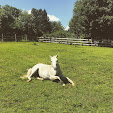A short history of the tallit: A tallit (pl: tallitot) is a shawl-like garment traditionally worn by Jewish men during daytime prayer (with the exception of evening Yom Kippur services). The main requirement is that at the four corners of a tallit there be fringes (tzitzit) which are tied and knotted in a manner that reminds one of the 613 mitzvot (commandments).
Starting in the 1970s, some liberal Jewish women have started adopting mitzvot from which they were traditionally excluded, and one of the more popular mitzvot to adopt has been wearing a tallit in synagogue. Part of it, I think, is that wearing a big tallit makes a clear visual statement. Another is that since the body of a tallit can be made in any fabric that isn't a wool-linen blend, and with any design that is appropriate for a religious garment, it can be highly individualized.
At my synagogue, most of the women who attend regularly wear tallitot, and all the bnot mitzvah (bat mitzvah age girls) are given a tallit by their parents for their bat mitzvah.
Most of the women's tallitot I've seen in synagogue are quite beautiful, but I have seen certain categories of tallitot:
The Blue (or Black) Striped Wool Tallit:
Most tallit-wearing men tend to have a simple white tallit with blue or black stripes, but I've also seen them worn by middle-aged women. They (the tallitot) have a quiet dignity, and I think help prevent the synagogue from becoming a tallitot fashion show.
The Pastel Striped Wool (or Silk) Tallit:
A "feminized" ode to the traditional royal blue or black striped tallit, sometimes incorporated with flowers and butterflies. Often seen on bnot mitzvah.
The Semi-Sheer Silk Tallit:
Often comes with a matching yarmulke, in shades of light purple, pink, or blue. I've only seen these on bnot mitzvah, and think of it as a young woman's tallit.
The Wool (or Silk) Tallit with a Jerusalem Skyline:
These tallitot come in many different colors, all depicting the Old City, and I've seen more subtle ones on men and bnai mitzvah. Their wearers seem to have a wider age range than those of other tallitot. Some of them have doves, which can be connected to the story of Noah and a hope for peace in Jerusalem.
The Tallit with Matriachs and/or Prophetesses:
Often made of painted or embroidered silk, these tallitot celebrate the women of the Bible. One popular variant has the names of the matriachs on the four corners.
My Mommy Made This:
Many bnot mitzvah (and bnai mitzvah) receive tallitot made by their mother or another close female relative. These tallitot are the most personalized, often featuring the child's name and symbols pertaining to the Torah portion they read for their bar/bat mitzvah. Seeing these tallitot gives me a warm fuzzy feeling, partly because my mom and I made my tallit together.
I Made This:
Many women have also made their own tallitot, sometimes choosing to incorporate something from the past, such as a grandmother's shawl or a father's old neckties. A lot of times there's a interesting story behind the design and making of their tallitot, and you can learn a lot about the seamstress from her tallit.
